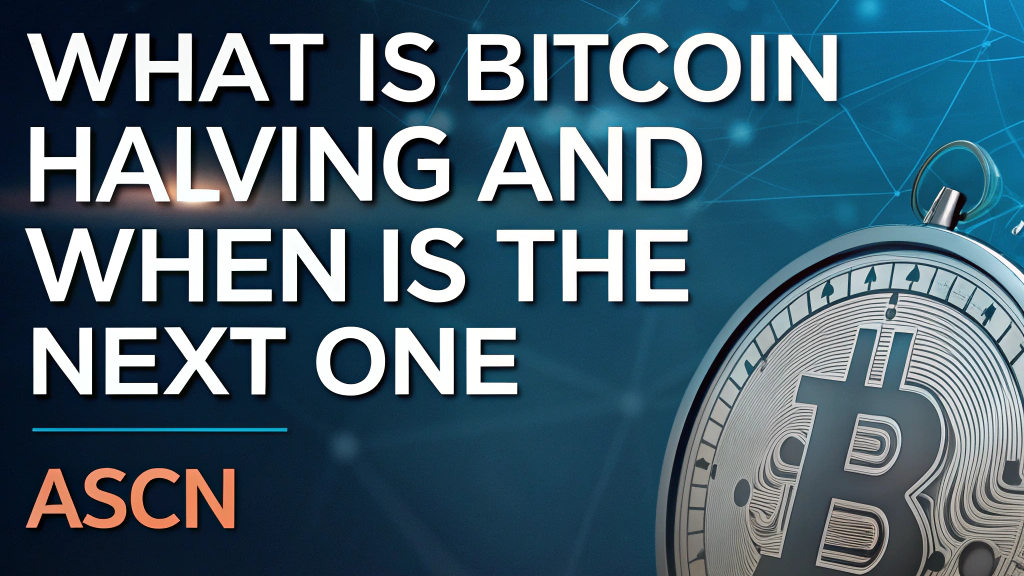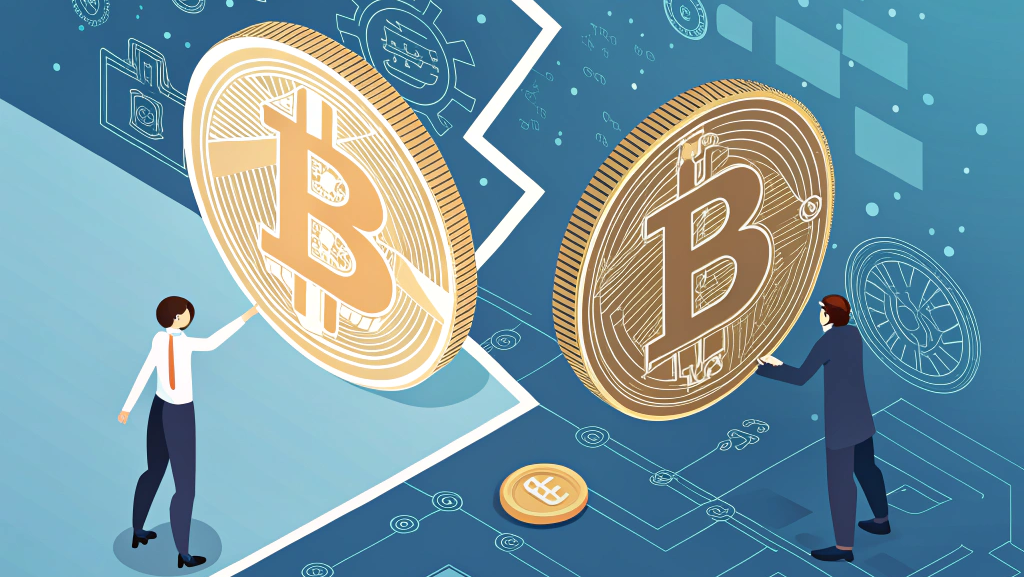What is Bitcoin halving and when is the next one — ASCN

What Bitcoin Halving Is and When the Next One Happens — ASCN
Halving is one of those Bitcoin topics that never gets old. Every four years or so, the community starts buzzing again — traders speculate, miners run the numbers, and investors argue about what it all means. It’s not just another technical tweak. It’s an event that literally rewrites Bitcoin’s economy.
So, What Exactly Is Bitcoin Halving?
At first glance, “halving” sounds like some kind of crypto jargon. But the term’s meaning is quite literal — it comes from to halve, meaning “to cut in half.” And that’s exactly what happens.

The Simple Definition
Bitcoin halving is the process that reduces miners’ block rewards by half. It takes place roughly every four years, or every 210,000 blocks.
In plain terms: when Bitcoin launched, miners earned 50 BTC per block. Later that became 25, then 12.5, and so on. As of 2025, they’re getting 3.125 BTC — the result of the 2024 halving. The next one will slash it to just 1.5625 BTC.
Why Halving Exists in the First Place
When Satoshi Nakamoto designed Bitcoin, he didn’t just build digital money — he coded in an entire monetary policy. One key rule: there will never be more than 21 million BTC. That’s it. No extra printing, no central committee changing the rules mid-game.
Halving is the mechanism that enforces scarcity. Every time it happens, the flow of new bitcoins entering circulation slows by half. Imagine if gold suddenly became twice as hard to mine — that’s the kind of pressure halving creates.
Built-In Defense Against Inflation
The core idea behind halving is simple: stop inflation before it starts. Unlike fiat currencies, which central banks can expand endlessly, Bitcoin has a fixed supply. Fewer new coins means greater scarcity — and, assuming demand stays steady, that scarcity tends to push the price up.
That’s why Bitcoin is often called digital gold: not because of its color or shine, but because its rarity is coded right into the protocol.
How It Affects Miners and the Market
Okay, theory aside — what does halving actually do in practice? That depends on which side you’re on.
Smaller Rewards, Tougher Economics
After every halving, miners’ earnings drop by half overnight. Unless the price doubles, mining suddenly becomes less profitable. For example: before 2024, a block paid 6.25 BTC. Afterward — 3.125 BTC. At $50,000 per coin, that’s a difference between $312,500 and $156,250 per block. Ouch.
The Mining Shake-Out
Mining today isn’t some guy’s PC humming in a bedroom. It’s industrial — massive data centers with thousands of ASICs running nonstop. Electricity, cooling, maintenance — all expensive. So when rewards shrink but costs don’t, smaller players simply can’t keep up. They shut down, and the network consolidates around those who can mine efficiently at scale.
Temporary Drop in Hashrate
The network’s total computing power, or hashrate, usually dips right after halving. But that doesn’t last long. History shows the strongest miners survive, hardware upgrades continue, and as prices climb again, the hashrate rebounds — often stronger than before.
Traders’ and Investors’ Reaction
Here’s the pattern: months before a halving, people start buying. They know new supply is about to shrink. The market heats up, sometimes too much. After the halving, a short cooldown often follows — profit-taking, recalibration. But within a year or so, the price tends to surge again.
That’s why many investors simply buy ahead of time and HODL through the cycle.
A Quick Look Back: The History of Bitcoin Halvings
To see how this all plays out, it helps to rewind. Bitcoin launched in 2009, and we’ve already seen four halvings. Each one changed the landscape — price action, mining, and investor behavior — in its own way.
The First Halving — 2012
It happened on November 28, 2012. The reward dropped from 50 to 25 BTC. At the time, Bitcoin traded around $12–13. A year later, it was over $1,000. That was the first major “bubble” — and the first time people realized Bitcoin’s potential value.
The ecosystem was tiny back then: few exchanges, even fewer investors, and mining mostly done on home computers.
The Second Halving — 2016
On July 9, 2016 (block 420,000), the reward fell to 12.5 BTC. The price was around $650. A year later, Bitcoin hit nearly $20,000. That cycle kicked off the ICO craze and brought a flood of new money into crypto. In many ways, it was the moment the industry grew up.
The Third Halving — 2020
May 11, 2020, block 630,000. Reward: 6.25 BTC. Bitcoin’s price: about $8,800. Within a year, it reached nearly $64,000. Institutions like Tesla and MicroStrategy jumped in, and “digital gold” became part of mainstream finance talk.
At first, the price actually dipped. But a few months later, we saw one of the strongest bull runs in Bitcoin’s history.
The Fourth Halving — 2024
The most recent one occurred on April 19, 2024 (block 840,000). Reward: 3.125 BTC. The price was roughly $62,000. The market barely reacted at first — many analysts believed the effect was “priced in.”
But by mid-2025, Bitcoin was flirting with $120,000. And according to some forecasts, that might just be the halfway point of this cycle.
BTC Price Growth After Each Halving
| Halving Year | Price at Event | Post-Halving Peak | Growth |
| 2012 | ~$12 | ~$1,150 (2013) | ~9,500% |
| 2016 | ~$650 | ~$19,700 (2017) | ~2,900% |
| 2020 | ~$8,800 | ~$64,000 (2021) | ~627% |
| 2024 | ~$62,000 | ~$120,000 (Jul 2025) | ~100% |
When’s the Next Halving? — Around 2028
Probably the most common question: when’s the next one?
It’s not tied to a calendar date but to block height. Still, we can estimate.
Expected Timing
The fifth halving will happen at block 1,050,000 — likely sometime in spring or early summer 2028. April 2028 is the most frequent forecast, though mining speed could shift that by a week or two.
How Many Blocks Left
By mid-2025, around 70,000 blocks had been mined since the 2024 event. That leaves roughly 140,000 to go. At ten minutes per block, we’ve got just under three years left — not as far away as it sounds. Big investors start positioning themselves long before the countdown hits zero.
Analyst Forecasts for 2025–2026
Here’s what’s being discussed on trading desks right now:
-
2025: Bitcoin could reach $135K+ if institutional interest keeps building.
-
2026: A corrective phase might follow — just like in previous cycles.
-
Pre-2028: About a year before the next halving, a new bull impulse could kick in.
Some analysts even call the upcoming halving the most important yet, since it’ll push Bitcoin into ultra-low emission territory — just 1.5625 BTC per block.
Can the Exact Date Be Predicted?
Not really. It’s block-based, not time-based.
If the network’s hashrate jumps, blocks are mined faster, and the halving comes a bit sooner. If it slows down, later. The margin of error is about one to two weeks. By 2027, we’ll have a pretty precise window.
Why Halving Usually Triggers Price Growth
It all comes down to basic economics: supply shrinks, demand stays steady.
Before halving, miners might sell around 900 BTC per day. Afterward — 450. At the same time, institutions, funds, and even governments keep buying. The imbalance pushes prices upward.
It’s not magic. It’s math — scarcity meeting demand.
The Market Pattern: Before and After
Here’s a fun quirk: the rally often starts before the halving. Investors “price in” the event six to twelve months early. After the event, the market cools — people take profits, miners adjust. Then, the real uptrend begins, often lasting more than a year.
Bitcoin’s 4-Year Market Cycle
Each halving tends to reset the cycle:
-
Accumulation – slow growth, quiet optimism.
-
Halving – supply shock, new capital inflow.
-
Bull Market – strong rally, retail joins in.
-
Peak – euphoria, media hype.
-
Correction – sharp drop, cleansing phase.
-
Base Formation – calm before the next wave.
That’s why long-term investors often build strategies around halving dates — buying during quiet times and holding through the storm.
Looking Ahead: What Happens After 2030
By 2032, block rewards will drop below 1 BTC — about 0.78125 BTC, to be precise. That’s less than 1% of the original 50 BTC reward from 2009.
Mining profitability will rely more on transaction fees than block rewards. If Bitcoin’s price keeps rising, even that small payout will still matter. And as on-chain activity grows, fees could become a major revenue source.
The Very Last Halving
That final halving is expected around the year 2140. After that, no new bitcoins — all 21 million will have been mined. From then on, miners will earn only from fees.
That’s why the Bitcoin community is already exploring scaling solutions — to ensure a sustainable fee-based economy once the minting phase ends.
Long-Term Impact on Investors
Understanding halving cycles lets investors plan years ahead. One popular approach is the so-called “four-year cycle”: buy after a halving, sell near the next peak.
No one can promise history will repeat perfectly. Still, halving remains a powerful signal — the heartbeat of Bitcoin’s deflationary system.
Why Halving Matters So Much
It’s the clock that sets Bitcoin’s rhythm — shaping its price, its mining economics, and its very narrative. Without halving, Bitcoin would slowly inflate like fiat currencies. With it, scarcity stays intact, and every new coin becomes harder to earn.
Each halving resets the market, filters out weak players, and gives the ecosystem fresh momentum. In a way, it’s Bitcoin’s built-in reboot button.
FAQ — Common Questions
Can you actually make money on halving?
Potentially, yes. But it’s not automatic. Many investors accumulate BTC six to twelve months before the event and sell a year or so after. There’s no guaranteed formula, though.
What should you do with BTC before and after?
If you’re already holding, halving doesn’t require any action. Still, it’s smart to expect volatility.
-
Before the halving: price often rises on hype.
-
After: short-term corrections are common, but the long-term trend tends to remain bullish.
Some traders lock in profits, others just keep holding — depends on your risk appetite.
Is halving automatic?
Yes, 100%. It’s written into Bitcoin’s code and triggers every 210,000 blocks automatically. No committees, no voting, no central authority. That’s part of Bitcoin’s appeal — monetary policy by algorithm.
How can I check the exact date?
You can’t pin it down to the day yet, but tools like ASCN.AI get pretty close. The platform tracks block data, hash rates, and investor sentiment in real time. Instead of digging through dozens of sites, you can see it all in one dashboard.
And when the market gets chaotic — as it usually does around halving — having ASCN.AI crunch the data for you can save a lot of guesswork (and maybe a few sleepless nights).
Bitcoin’s market may be emotional and unpredictable, but its data is not. Halving keeps that logic intact — the math of scarcity that underpins the world’s first decentralized currency


